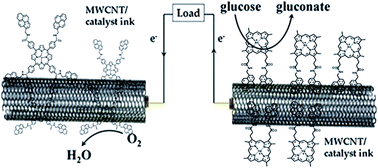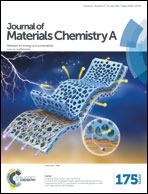Glucose fuel cell based on carbon nanotube-supported pyrene–metalloporphyrin catalysts†
Abstract
It is important to design a functionalization scheme for carbon nanotubes that preserves their outstanding proprieties, while adding new proprieties, thereby enabling their integration in fuel cell applications. In the present work, we describe the production of a non-covalently attached network of porphyrins to multi-walled carbon nanotubes (MWCNT) sidewalls. The approach is based on π–π stacking interactions of pyrene-modified metalloporphyrins onto MWCNT sidewalls. Two configurations of MWCNT–porphyrin hybrid electrodes were both electrochemically characterized and tested under alkaline conditions. Pyrene-functionalized rhodium deuteroporphyrin (Rh(DP)pyr2), was used as an anode in the electrocatalytic oxidation of glucose and pyrene-functionalized tetracarboxyphenyl cobalt porphyrin (Co(TCPP)pyr4) was itself used as a cathode in the electrocatalytic reduction of oxygen. Both electrodes were integrated into a glucose fuel cell system leading to a maximum power output of 0.9(±0.10) mW cm−2. Compared to alternative system approaches, pyrene-modified porphyrin hybrid electrodes and their corresponding fuel cell devices exhibited higher activity, power output, and long term stability.


 Please wait while we load your content...
Please wait while we load your content...